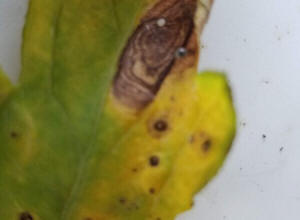|
Illinois Extension receives many questions about
these plants and their care each year, with most questions centering
on the control of some common ailments. However, relatively easy
cultural practices can solve most common tomato problems.
Tomato Hornworm

Perhaps the foremost insect pest on tomato plants,
the tomato hornworm (Manduca quinquemaculata), is about to appear
for the 2023 growing season. These defoliating larvae emerge from
pupa in July after overwintering in the soil. They are native to
North America with a large home range spanning sea to sea.
Identifying the damage that ensues after they hatch is often very
easy. The little critters are big consumers of leaves, fruits, and
smaller stems on tomato plants, leaving very noticeable damage in as
little as a day. I have always had excellent control from timely
hand removal of these caterpillars, but it does take a watchful eye.

During the daytime, these guys hang out in the shady lower portion
of the plant, waiting for their favorite time to feed after dark. At
night, they are easily found feeding in the tiptops of plants. I
make the rounds each evening to quickly pluck them off the branch
tips as they are fully displayed in the moonlight. Daytime control
efforts often take quite a bit of additional searching, and it's
hard to find them all.
Early Blight

Early blight is a foliar disease caused by the fungal
pathogen Alternaria solani. It appears as yellow spots on lower
leaves which enlarge into concentric dark brown spots, eventually
withering and killing infected leaves. The disease always originates
on lower, older leaves and moves upward, creating a noticeable
pattern. As the infection worsens, it attacks petioles, stems, and
fruits. A. solani overwinters in infected plant debris at or near
the soil surface. During favorable spring conditions, the fungi
produce spores that are spread by splashing raindrops or wind to
infect leaves.

Since this pathogen moves from soil to leaves, a
mulch barrier is one of the most effective control measures. I’ve
had excellent control of this condition by mulching immediately
after planting my tomatoes, offering no opportunity for raindrops to
splash the fungi onto leaves. Watering plants with drip irrigation
or a soaker hose can also help immensely. Providing good air
circulation by staking plants and pruning excess foliage can limit
its spread by reducing favorable conditions, such as wet leaves.
Septoria Leafspot

Septoria leafspot is another fungal pathogen that
infects leaf tissues. It is characterized by small black spots on
leaves, with centers that later turn white and develop tiny black
dots. This disease also begins on lower leaves, thriving in wet
weather and spreading up the plant. It is transmitted from the soil,
much like early blight, with control recommendations identical for
each pathogen.
Both of these fungal diseases can also be addressed by keeping
plants healthy to limit susceptibility. Good fertilization (but not
over-fertilization) is part of that strategy including a starter
fertilizer at the time of planting, a side-dress application when
fruits are about golf ball sized, followed by 2 more applications
(spaced out 3-6 weeks) throughout the growing season. Follow product
instructions for the recommended rate for each application.
Blossom End Rot

Any internet search for “diseases of tomato fruits”
will turn up lots of information on blossom end rot (BER), but you
may find varying accounts of what exactly is causing this disease.
In addition, this ailment is not actually a disease, but a
physiological disorder, or a disorder related to the physical
function of the plant. It is not caused by a pathogen, as is the
case with diseases. [to top of second
column] |

The symptoms of BER are hard to
miss, beginning as a tan or brown spot and expanding into a
sunken, dark-colored and often leathery area of rot that
typically ruins most of the fruit. This rot develops on the
blossom end of the fruit, or the end opposite of the stem, where
the flower was once attached.
Unfortunately, once the brown or black end on the fruit appears,
it's too late, and these fruits need to be removed so they don’t
draw any additional plant resources. There is no way to reverse
or slow the development of this condition once it begins.
BER can also affect peppers, squash, eggplant, and watermelon.
Certain tomatoes are more susceptible, with the larger-fruited
varieties having a higher incidence of BER. Tomatoes with longer
fruits, such as ‘Roma,’ have also shown higher susceptibility
than those with more round fruits.
The mechanisms that cause BER are poorly understood, but most
believe the condition relates to calcium levels in the
developing fruit. In central Illinois, calcium is typically
abundant in soils. However, the uptake of this soil
macronutrient in tomato plants can be tricky and is tied to
various environmental factors.

Essentially, the uptake of calcium is dependent on
the active transpiration of leaves. Recall that transpiration is the
process by which leaves wick moisture (and nutrients) from the soil
by expelling moisture through stomatal openings in leaves. Any
environmental stress, such as too much or too little soil moisture
that affects transpiration, can impact calcium uptake. Other factors
such as soil salinity (affected by fertilizer application), humidity
levels, and ambient temperature during fruit development have all
been shown to affect calcium uptake and transport to developing
fruits.
Some researchers have identified calcium deficiency as a symptom of
BER instead of a cause. In these cases, researchers noted that
fruits had adequate calcium levels early in development and lower
levels after the onset of BER.
Regardless of the exact cause, there are some recommendations you
can try to prevent BER. First, avoid overfertilization and use
ammonium-based fertilizers (ammonium interferes with calcium
uptake). Another option is to select varieties less prone to BER,
such as cherry tomatoes and more round-shaped fruit varieties.
However, the most effective recommendation is to provide consistent
soil moisture, especially during the early stages of fruit
development. Avoid large swings in soil moisture by watering deeply
(as opposed to frequent, shallow watering) and providing at least
one inch of water per week. If hot, dry weather is predicted, water
your plants in advance. Mulch can help greatly regulate large swings
in soil moisture, adding yet another benefit to the long list we can
attribute to mulching.
Harvesting Recommendations
To conclude this discussion of common tomato problems, I’d like to
talk briefly about harvesting as we get quite a few questions about
how and when to harvest tomatoes for optimal fruit conditions. The
highest quality tomatoes are ripened on the vine when average daily
temperatures are about 75°F. Harvest fruits when they are firm and
fully colored and do not refrigerate.
As temperatures rise, the softening process is accelerated, and
color development is slowed. Once the hot weather of July and August
sets in, it pays to harvest tomatoes every day or two as new fruits
have started to develop color. The ripening process can then be
completed indoors under more optimal temperatures (70-75°F).
References
Adams, P and Ho, LC. 1993. Effects of environment on the uptake and
distribution of calcium in tomato and on the incidence of
blossom-end rot. Plant and Soil 154, 127–132.
Adams, P. 1991. Effect of diurnal fluctuations in humidity on the
accumulation of nutrients in the leaves of tomato (Lycopersicon
esculentum). J. Horticulture Science 66, 545–550.
Colebrook, EH et al. 2014. The role of gibberellin signaling in
plant response to abiotic stress. Journal of Experimental Biology
217(1), 67-75.
Chaerani, R and Voorrips, RE. 2006. Tomato early blight (Alternaria
solani): the pathogen, genetics and breeding for resistance. Journal
of General Plant Pathology 72, 335-347.
De Freitas, ST and Mitchum, EJ. 2012. Factors involved in fruit
calcium deficiency disorders. Horticultural Review, 107-146.
Hagassou, D et al. 2019. Blossom end-rot in tomato (Lycopersicon
esculentum L.): a multi-disciplinary overview of inducing factors
and control strategies. Scientia Horticulturae 249, 49-58.
Saure, MC. 2014. Why calcium deficiency is not the cause of
blossom-end rot in tomato and pepper fruit. Scientia Horticulturae
174, 151-154.
[Ryan Pankau, Horticulture Educator,
University of Illinois Extension]

|